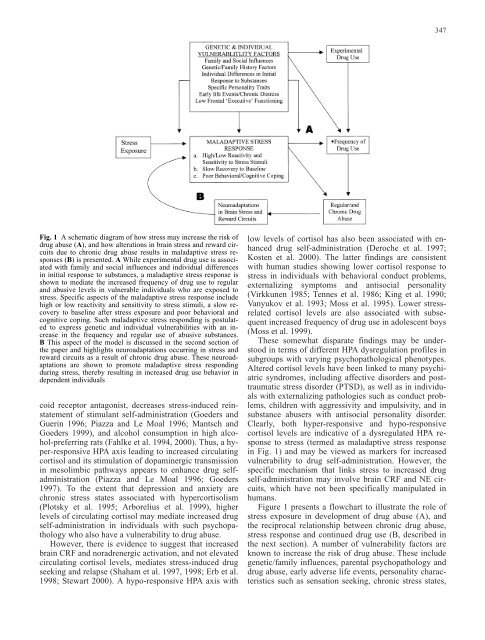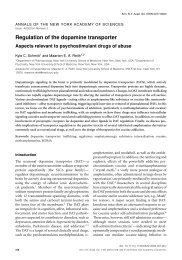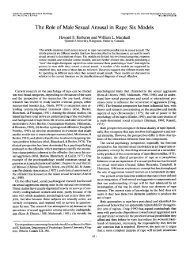How does stress increase risk of drug abuse - Addiction Research ...
How does stress increase risk of drug abuse - Addiction Research ...
How does stress increase risk of drug abuse - Addiction Research ...
You also want an ePaper? Increase the reach of your titles
YUMPU automatically turns print PDFs into web optimized ePapers that Google loves.
Fig. 1 A schematic diagram <strong>of</strong> how <strong>stress</strong> may <strong>increase</strong> the <strong>risk</strong> <strong>of</strong><br />
<strong>drug</strong> <strong>abuse</strong> (A), and how alterations in brain <strong>stress</strong> and reward circuits<br />
due to chronic <strong>drug</strong> <strong>abuse</strong> results in maladaptive <strong>stress</strong> responses<br />
(B) is presented. A While experimental <strong>drug</strong> use is associated<br />
with family and social influences and individual differences<br />
in initial response to substances, a maladaptive <strong>stress</strong> response is<br />
shown to mediate the <strong>increase</strong>d frequency <strong>of</strong> <strong>drug</strong> use to regular<br />
and abusive levels in vulnerable individuals who are exposed to<br />
<strong>stress</strong>. Specific aspects <strong>of</strong> the maladaptive <strong>stress</strong> response include<br />
high or low reactivity and sensitivity to <strong>stress</strong> stimuli, a slow recovery<br />
to baseline after <strong>stress</strong> exposure and poor behavioral and<br />
cognitive coping. Such maladaptive <strong>stress</strong> responding is postulated<br />
to express genetic and individual vulnerabilities with an <strong>increase</strong><br />
in the frequency and regular use <strong>of</strong> abusive substances.<br />
B This aspect <strong>of</strong> the model is discussed in the second section <strong>of</strong><br />
the paper and highlights neuroadaptations occurring in <strong>stress</strong> and<br />
reward circuits as a result <strong>of</strong> chronic <strong>drug</strong> <strong>abuse</strong>. These neuroadaptations<br />
are shown to promote maladaptive <strong>stress</strong> responding<br />
during <strong>stress</strong>, thereby resulting in <strong>increase</strong>d <strong>drug</strong> use behavior in<br />
dependent individuals<br />
coid receptor antagonist, decreases <strong>stress</strong>-induced reinstatement<br />
<strong>of</strong> stimulant self-administration (Goeders and<br />
Guerin 1996; Piazza and Le Moal 1996; Mantsch and<br />
Goeders 1999), and alcohol consumption in high alcohol-preferring<br />
rats (Fahlke et al. 1994, 2000). Thus, a hyper-responsive<br />
HPA axis leading to <strong>increase</strong>d circulating<br />
cortisol and its stimulation <strong>of</strong> dopaminergic transmission<br />
in mesolimbic pathways appears to enhance <strong>drug</strong> selfadministration<br />
(Piazza and Le Moal 1996; Goeders<br />
1997). To the extent that depression and anxiety are<br />
chronic <strong>stress</strong> states associated with hypercortisolism<br />
(Plotsky et al. 1995; Arborelius et al. 1999), higher<br />
levels <strong>of</strong> circulating cortisol may mediate <strong>increase</strong>d <strong>drug</strong><br />
self-administration in individuals with such psychopathology<br />
who also have a vulnerability to <strong>drug</strong> <strong>abuse</strong>.<br />
<strong>How</strong>ever, there is evidence to suggest that <strong>increase</strong>d<br />
brain CRF and noradrenergic activation, and not elevated<br />
circulating cortisol levels, mediates <strong>stress</strong>-induced <strong>drug</strong><br />
seeking and relapse (Shaham et al. 1997, 1998; Erb et al.<br />
1998; Stewart 2000). A hypo-responsive HPA axis with<br />
347<br />
low levels <strong>of</strong> cortisol has also been associated with enhanced<br />
<strong>drug</strong> self-administration (Deroche et al. 1997;<br />
Kosten et al. 2000). The latter findings are consistent<br />
with human studies showing lower cortisol response to<br />
<strong>stress</strong> in individuals with behavioral conduct problems,<br />
externalizing symptoms and antisocial personality<br />
(Virkkunen 1985; Tennes et al. 1986; King et al. 1990;<br />
Vanyukov et al. 1993; Moss et al. 1995). Lower <strong>stress</strong>related<br />
cortisol levels are also associated with subsequent<br />
<strong>increase</strong>d frequency <strong>of</strong> <strong>drug</strong> use in adolescent boys<br />
(Moss et al. 1999).<br />
These somewhat disparate findings may be understood<br />
in terms <strong>of</strong> different HPA dysregulation pr<strong>of</strong>iles in<br />
subgroups with varying psychopathological phenotypes.<br />
Altered cortisol levels have been linked to many psychiatric<br />
syndromes, including affective disorders and posttraumatic<br />
<strong>stress</strong> disorder (PTSD), as well as in individuals<br />
with externalizing pathologies such as conduct problems,<br />
children with aggressivity and impulsivity, and in<br />
substance <strong>abuse</strong>rs with antisocial personality disorder.<br />
Clearly, both hyper-responsive and hypo-responsive<br />
cortisol levels are indicative <strong>of</strong> a dysregulated HPA response<br />
to <strong>stress</strong> (termed as maladaptive <strong>stress</strong> response<br />
in Fig. 1) and may be viewed as markers for <strong>increase</strong>d<br />
vulnerability to <strong>drug</strong> self-administration. <strong>How</strong>ever, the<br />
specific mechanism that links <strong>stress</strong> to <strong>increase</strong>d <strong>drug</strong><br />
self-administration may involve brain CRF and NE circuits,<br />
which have not been specifically manipulated in<br />
humans.<br />
Figure 1 presents a flowchart to illustrate the role <strong>of</strong><br />
<strong>stress</strong> exposure in development <strong>of</strong> <strong>drug</strong> <strong>abuse</strong> (A), and<br />
the reciprocal relationship between chronic <strong>drug</strong> <strong>abuse</strong>,<br />
<strong>stress</strong> response and continued <strong>drug</strong> use (B, described in<br />
the next section). A number <strong>of</strong> vulnerability factors are<br />
known to <strong>increase</strong> the <strong>risk</strong> <strong>of</strong> <strong>drug</strong> <strong>abuse</strong>. These include<br />
genetic/family influences, parental psychopathology and<br />
<strong>drug</strong> <strong>abuse</strong>, early adverse life events, personality characteristics<br />
such as sensation seeking, chronic <strong>stress</strong> states,










